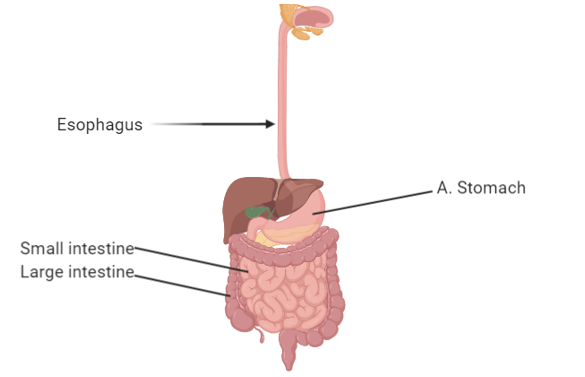
What is the length of the alimentary canal in human beings? List out the parts of the gastrointestinal tract in the correct sequential order based on the passage of food.
Answer
544.2k+ views
Hint:Along with those associated glands, the food canal is the entire digestive system of our body. The arrangement and size of the different organs of the food canal depend on the role of the organ.
Complete answer:
In humans, the food canal stretches from the mouth to the anus. It is between 8 to 10 meters long in humans. The basic organs of the food canal are the mouth, the esophagus, the stomach, the small intestine, and the large intestine. The food canal has two openings. The opening at the anterior end is the mouth, and the anus at the posterior end.
The various organs of the food canal can be described as:
The first part of the food canal where partial digestion of food takes place with the help of saliva include the teeth and tongue. Food falls from the mouth to the food pipe or to the esophagus.

The gastrointestinal tract may be separated into the upper and lower tracts. The oral cavity, pharynx, esophagus, stomach, and duodenum are part of the upper gastrointestinal tract, while the small intestine and large intestine are part of the lower tract.
The small intestine is further divided into duodenum, jejunum, and ileum, while the ascending colon, transverse colon, descending colon, and rectum is located in the large intestine.
Food travels in series through the following organs: oral cavity or mouth, pharynx, esophagus, stomach, small intestine (duodenum, jejunum, and ileum), large intestine (cecum, colon, rectum), and anus.
Note: The primary function of the small intestine is the absorption of nutrients and a maximum amount of surface area is needed for this function. In order to increase its surface area, it also bears several finger-like projections called villi and microvilli on its internal surface. That's why small intestines are too long. Unlike the act of feeding, the nutrients are absorbed very slowly, since the length of the small intestine causes the process to take time (in hours).
Complete answer:
In humans, the food canal stretches from the mouth to the anus. It is between 8 to 10 meters long in humans. The basic organs of the food canal are the mouth, the esophagus, the stomach, the small intestine, and the large intestine. The food canal has two openings. The opening at the anterior end is the mouth, and the anus at the posterior end.
The various organs of the food canal can be described as:
The first part of the food canal where partial digestion of food takes place with the help of saliva include the teeth and tongue. Food falls from the mouth to the food pipe or to the esophagus.

The gastrointestinal tract may be separated into the upper and lower tracts. The oral cavity, pharynx, esophagus, stomach, and duodenum are part of the upper gastrointestinal tract, while the small intestine and large intestine are part of the lower tract.
The small intestine is further divided into duodenum, jejunum, and ileum, while the ascending colon, transverse colon, descending colon, and rectum is located in the large intestine.
Food travels in series through the following organs: oral cavity or mouth, pharynx, esophagus, stomach, small intestine (duodenum, jejunum, and ileum), large intestine (cecum, colon, rectum), and anus.
Note: The primary function of the small intestine is the absorption of nutrients and a maximum amount of surface area is needed for this function. In order to increase its surface area, it also bears several finger-like projections called villi and microvilli on its internal surface. That's why small intestines are too long. Unlike the act of feeding, the nutrients are absorbed very slowly, since the length of the small intestine causes the process to take time (in hours).
Recently Updated Pages
Master Class 12 Business Studies: Engaging Questions & Answers for Success

Master Class 12 Economics: Engaging Questions & Answers for Success

Master Class 12 English: Engaging Questions & Answers for Success

Master Class 12 Maths: Engaging Questions & Answers for Success

Master Class 12 Social Science: Engaging Questions & Answers for Success

Master Class 12 Chemistry: Engaging Questions & Answers for Success

Trending doubts
What is meant by exothermic and endothermic reactions class 11 chemistry CBSE

Which animal has three hearts class 11 biology CBSE

10 examples of friction in our daily life

One Metric ton is equal to kg A 10000 B 1000 C 100 class 11 physics CBSE

1 Quintal is equal to a 110 kg b 10 kg c 100kg d 1000 class 11 physics CBSE

Difference Between Prokaryotic Cells and Eukaryotic Cells




